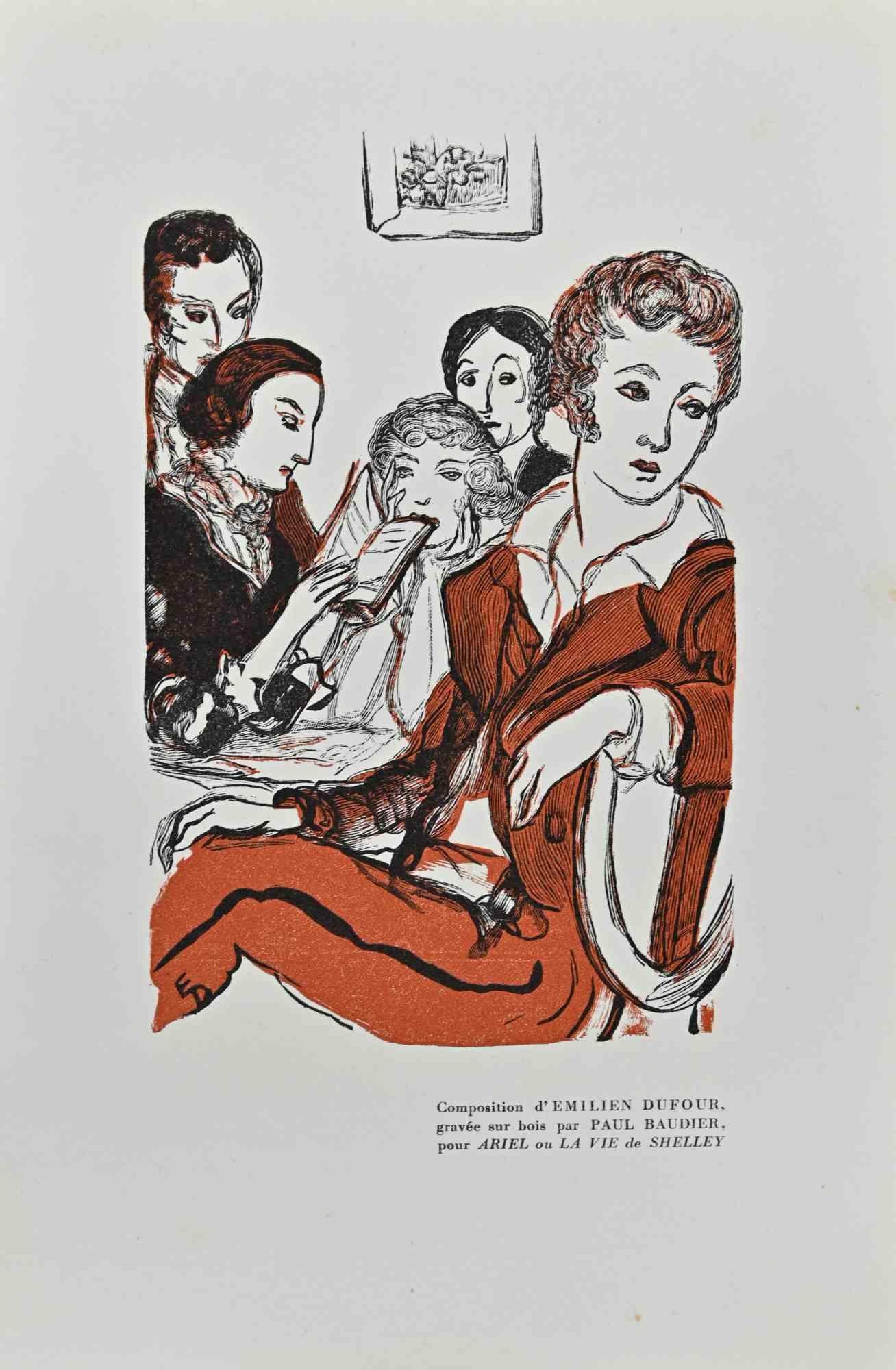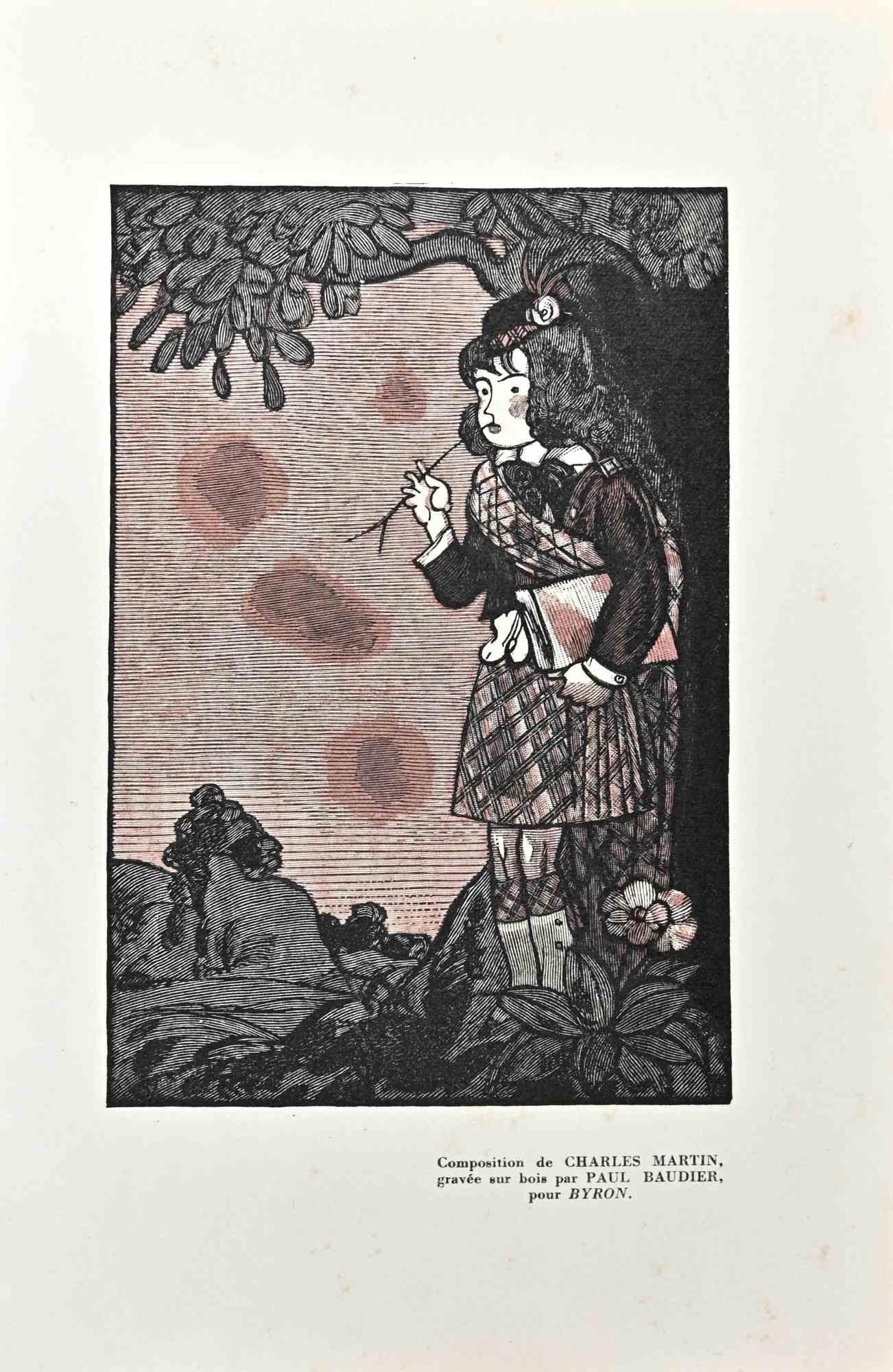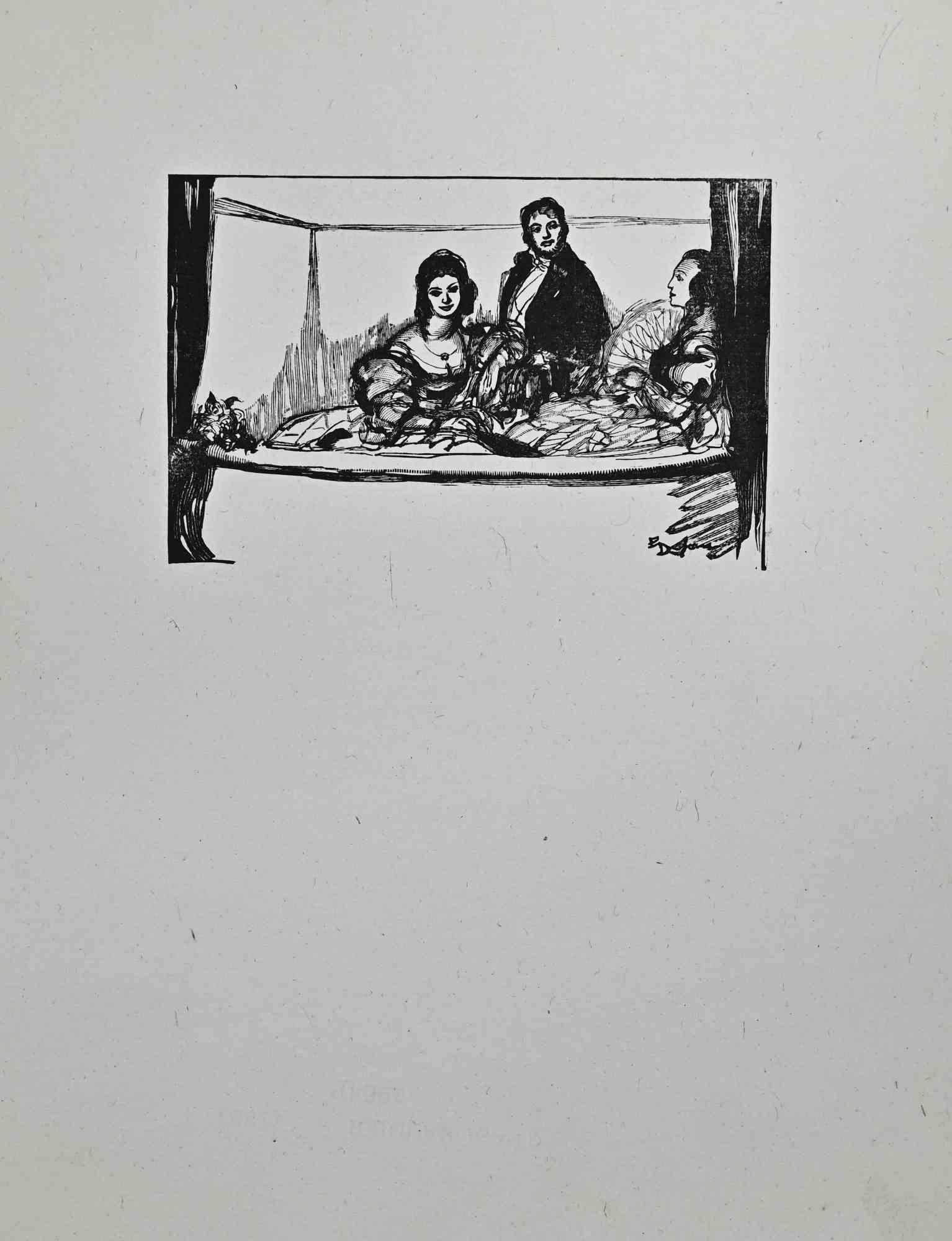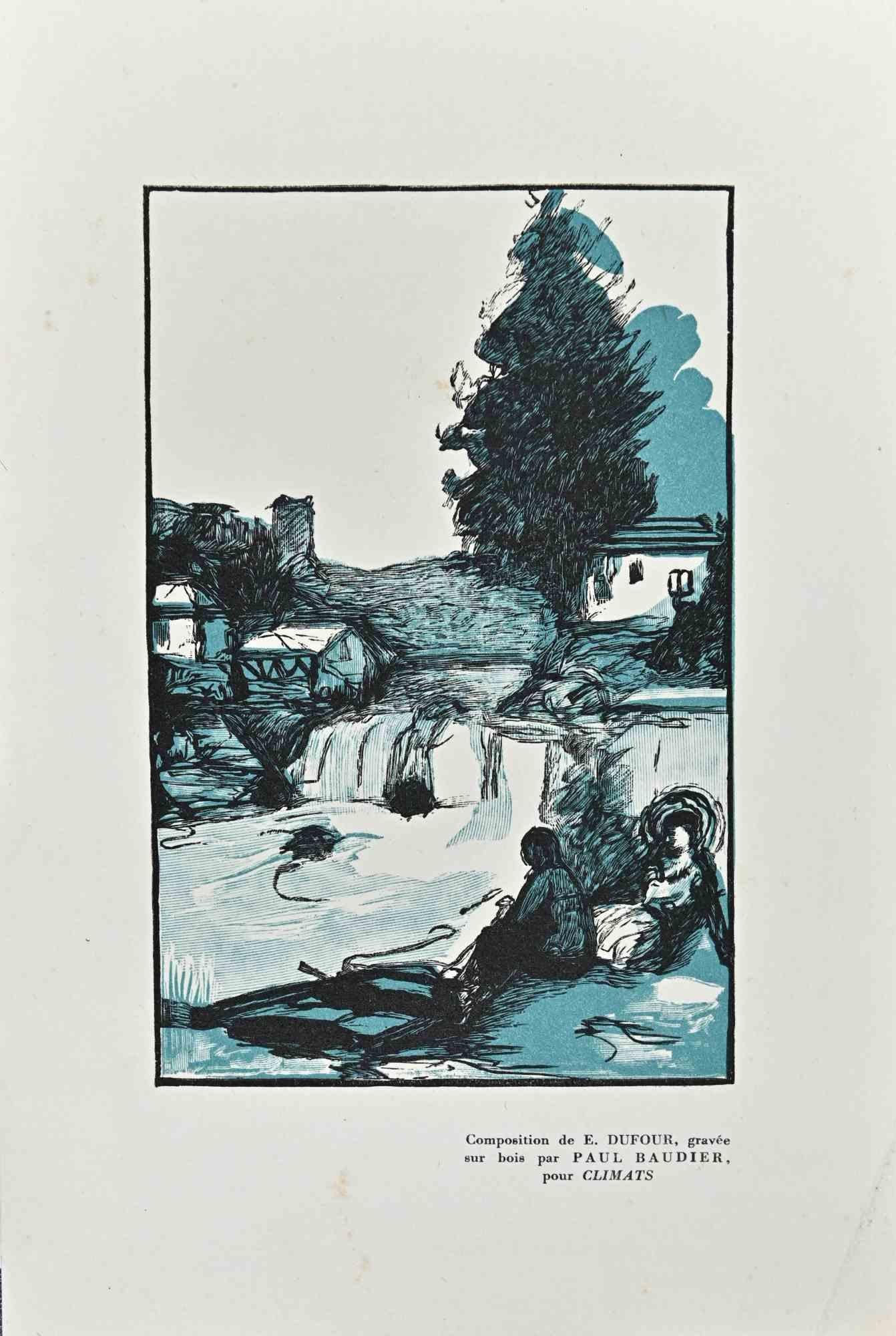Items Similar to Lovers - Woodcut after Ikkeisai Yoshichika - Mid-20th Century
Want more images or videos?
Request additional images or videos from the seller
1 of 3
Ikeisai YoshichikaLovers - Woodcut after Ikkeisai Yoshichika - Mid-20th CenturyMid-20th Century
Mid-20th Century
About the Item
Lovers with a Bird Cage is a woodcut print realized in the mid-20th Century after a 1789 woodcut print by Suzuki Harunobu.
Good conditions.
The artwork is depicted through soft lines in a well-balanced composition.
- Creator:Ikeisai Yoshichika
- Creation Year:Mid-20th Century
- Dimensions:Height: 11.23 in (28.5 cm)Width: 8.27 in (21 cm)Depth: 0.08 in (2 mm)
- Medium:
- Period:
- Framing:Framing Options Available
- Condition:Insurance may be requested by customers as additional service, contact us for more information.
- Gallery Location:Roma, IT
- Reference Number:Seller: T-1346541stDibs: LU650311074842
About the Seller
4.9
Platinum Seller
These expertly vetted sellers are 1stDibs' most experienced sellers and are rated highest by our customers.
1stDibs seller since 2017
6,749 sales on 1stDibs
Typical response time: 2 hours
- ShippingRetrieving quote...Ships From: Rome, Italy
- Return PolicyA return for this item may be initiated within 14 days of delivery.
Auctions on 1stDibs
Our timed auctions are an opportunity to bid on extraordinary design. We do not charge a Buyer's Premium and shipping is facilitated by 1stDibs and/or the seller. Plus, all auction purchases are covered by our comprehensive Buyer Protection. Learn More
More From This SellerView All
- Studio - Woodcut -Japan - Mid-20th CenturyLocated in Roma, ITStudio is an original woodcut print realized in the Mid-20th Century. Good conditions. The artwork is represented in harmonious colors in a well-balanced composition.Category
Mid-20th Century Modern Figurative Prints
MaterialsWoodcut
- Les Femmes de ce Temps - Original Woodcut by Louis Jou - 1920sBy Louis JouLocated in Roma, ITLes Femmes de ce Temps is an original woodcut realized by Louis Jou in the 1920s . Good conditions. Louis Jou (Gracia, 1882 - Baux, 1968), the twentieth-century etcher and wood engraver, was a prolific illustrator of a large number of books in France, authored by big names like Andre Gide...Category
1920s Modern Figurative Prints
MaterialsWoodcut
- The Misery - Original Woodcut print by André Baudier - 1930sLocated in Roma, ITThe Misery is an original woodcut print on ivory-colored paper realized by André Baudier in the 1930s. On the lower right description in French. Very good conditions.Category
1930s Modern Figurative Prints
MaterialsWoodcut
- The Carriage of Women - Original Woodcut Print by Paul Baudier - 1930sLocated in Roma, ITThe Carriage of Women is an original woodcut print on ivory-colored paper realized by Paul Baudier (1881-1962) in the 1930s. Very Good condition. Paul Baudier, (born October 18, 18...Category
1930s Modern Figurative Prints
MaterialsWoodcut
- Rendez-vous - Original Woodcut Print by Paul Baudier - 1930sLocated in Roma, ITRendezvous is an original woodcut print on ivory-colored paper realized by Paul Baudier (1881-1962) in the 1930s. On the lower right description in French. Very good conditions. P...Category
1930s Modern Figurative Prints
MaterialsWoodcut
- By The River - Original Woodcut Print by Paul Baudier - 1930sLocated in Roma, ITBy The River is an original woodcut print on ivory-colored paper realized by Paul Baudier (1881-1962) in the 1930s. On the lower right description in French. Very good conditions. ...Category
1930s Modern Figurative Prints
MaterialsWoodcut
You May Also Like
- Ada - Portrait Print by Alex Katz, Ada, Red, Pearl Necklace, Portrait, Pop ArtBy Alex KatzLocated in Köln, DE"Ada" from 2011 is a Japanese woodblock in thirty-one colors on New Hosho paper. We are offering the number 18/70. 3 Artist's proofs. Ada is Alex Katz' wife and his most important mu...Category
2010s Pop Art Figurative Prints
MaterialsWoodcut
- Grün VI (Green VI) - 21st Century, Georg Baselitz, Green, PortraitBy Georg BaselitzLocated in Köln, DE"Grün VI" is a motif from a range of woodcuts showing similar motifs in the same green colour. Baselitz is digesting his memories of the time shortly after the end of World War II in...Category
1990s Neo-Expressionist Figurative Prints
MaterialsWoodcut
- Coal Miners - INDUSTRIAL ART - Pre War German School - Large signed WoodcutLocated in Meinisberg, CHHermann Kätelhön (German, * 22. September 1884, Hofgeismar; † 24. November 1940, München) Coal Miners • Woodcut, sheet measures ca. 55 x 40 cm • The sheet is mounted (fixed at the...Category
1920s Naturalistic Figurative Prints
MaterialsPaper, Ink, Woodcut
- Elia Shiwoohamba ( Namibia, 1981 ) Harvesting Time Lino Cut African School 2006By Elia ShiwoohamaLocated in Meinisberg, CHElia Shiwoohamba (* 1981 , Windhoek, Namibia ) Harvesting Time • African School • Linoleum cut • Sheet ca. 34.5 x 43 cm (Image is smaller) • Bottom left numbered 8/50 and titled • ...Category
Early 2000s Expressionist Landscape Prints
MaterialsPaper, Linocut, Woodcut
- Workers - INDUSTRIAL ART - Pre War German School - Signed LithographLocated in Meinisberg, CHHermann Kätelhön (German, * 22. September 1884 in Hofgeismar; † 24. November 1940 in München) Workers - Lithograph, Sheet ca. 56 x 41 cm - Signed bottom right - The photographs sho...Category
Early 20th Century Naturalistic Figurative Prints
MaterialsPaper, Pigment, Woodcut
- The Sheepherder by Lon MegargeeLocated in Phoenix, AZLon Megargee 1883-1960 "The Sheepherder" Wood block print Signed in plate, lower right Image size: 10 x 10 inches Frame size 22 x 22 inches Creator of Stetson's hat logo "Last Drop from his Hat" Lon Megargee 1883 - 1960 At age 13, Lon Megargee came to Phoenix in 1896 following the death of his father in Philadelphia. For several years he resided with relatives while working at an uncle’s dairy farm and at odd jobs. He returned to Philadelphia in 1898 – 1899 in order to attend drawing classes at the Pennsylvania Academy of the Fine Arts. Back in Phoenix in 1899, he decided at the age of 16 to try to make his living as a cowboy. Lon moved to the cow country of Wickenburg, Arizona where he was hired by Tex Singleton’s Bull Ranch. He later joined the Three Bar R. . . and after a few years, was offered a job by Billy Cook of the T.T. Ranch near New River. By 1906, Megargee had learned his trade well enough to be made foreman of Cook’s outfit. Never shy about taking risks, Lon soon left Cook to try his own hand at ranching. He partnered with a cowpuncher buddy, Tom Cavness, to start the El Rancho Cinco Uno at New River. Unfortunately, the young partners could not foresee a three-year drought that would parch Arizona, costing them their stock and then their hard-earned ranch. Breaking with his romantic vision of cowboy life, Megargee finally turned to art full time. He again enrolled at the Pennsylvania Academy of Art and then the Los Angeles School of Art and Design during 1909 – 1910. The now well-trained student took his first trip to paint “en plein air” (outdoors) to the land of Hopi and Navajo peoples in northern Arizona. After entering paintings from this trip in the annual Territorial Fair at Phoenix, in 1911, he surprisingly sold his first oil painting to a major enterprise – the Santa Fe Railroad . . . Lon received $50 for “Navajos Watching the Santa Fe Train.” He soon sold the SFRR ten paintings over the next two years. For forty years the railroad was his most important client, purchasing its last painting from him in 1953. In a major stroke of good fortune during his early plein-air period, Megargee had the opportunity to paint with premier artist, William R. Leigh (1866 – 1955). Leigh furnished needed tutoring and counseling, and his bright, impressionistic palette served to enhance the junior artist’s sense of color and paint application. In a remarkable display of unabashed confidence and personable salesmanship, Lon Megargee, at age 30, forever linked his name with Arizona art history. Despite the possibility of competition from better known and more senior artists, he persuaded Governor George Hunt and the Legislature in 1913 to approve 15 large, historic and iconic murals for the State Capitol Building in Phoenix. After completing the murals in 1914, he was paid the then princely sum of roughly $4000. His Arizona statehood commission would launch Lon to considerable prominence at a very early point in his art career. Following a few years of art schooling in Los Angeles, and several stints as an art director with movie studios, including Paramount, Megargee turned in part to cover illustrations for popular Western story magazines in the 1920s. In the 1920s, as well, Lon began making black and white prints of Western types and of genre scenes from woodblocks. These prints he generally signed and sold singly. In 1933, he published a limited edition, signed and hard-cover book (about 250 copies and today rare)containing a group of 28 woodblock images. Titled “The Cowboy Builds a Loop,” the prints are noteworthy for strong design, excellent draftsmanship, humanistic and narrative content, and quality. Subjects include Southwest Indians and cowboys, Hispanic men and women, cattle, horses, burros, pioneers, trappers, sheepherders, horse traders, squaw men and ranch polo players. Megargee had a very advanced design sense for simplicity and boldness which he demonstrated in how he used line and form. His strengths included outstanding gestural (action) art and strong figurative work. He was superb in design, originality and drawing, as a study of his prints in the Hays collection reveals. In 1944, he published a second group of Western prints under the same title as the first. Reduced to 16 images from the original 28 subjects, and slightly smaller, Lon produced these prints in brown ink on a heavy, cream-colored stock. He designed a sturdy cardboard folio to hold each set. For the remainder of his life, Lon had success selling these portfolios to museum stores, art fairs and shows, and to the few galleries then selling Western art. Drawing on real working and life experiences, Lon Megargee had a comprehensive knowledge, understanding and sensitivity for Southwestern subject matter. Noted American modernist, Lew Davis...Category
Early 20th Century American Impressionist Figurative Prints
MaterialsWoodcut
Recently Viewed
View AllMore Ways To Browse
Antique Lovers
Mid Century Woodcut
Midcentury Woodcut
Antique Bird Cages
Antique Bird In Cage
Figurative 20th Century Lovers
Harunobu Suzuki
Temple Print
Library Modern Italian
Signed Original Dali
Artist Proof Etching
Old Master Etchings And Engraving
Dali After
Large Art Exhibition Poster
Vintage Circus Circus
Vintage Circus
Circus Vintage
Erotic Art Print





